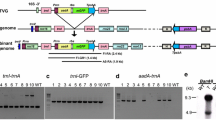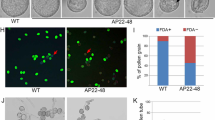Summary
In angiosperms, the pollen generative cell is the progenitor of the male gametes. In order to clone novel genes that are expressed specifically in male gametic cells, a simplified differentialdisplay method with total RNA was applied to isolated generative cells ofLilium longiflorum. At least three fragments were specifically amplified in generative cells in comparison with pollen and leaf cells. Northern blot analysis showed that one of these, which was named AP6-E, was part of a gene expressed strongly in generative cells. Reverse-transcriptase polymerase chain reaction analysis also revealed that the AP6-E gene was expressed during microsporogenesis and microspore development, and its expression was gradually reduced with pollen development. However, in situ hybridization demonstrated that transcripts of the AP6-E gene preferentially accumulated in the generative cell of nearly mature pollen. The isolation of AP6-E cDNA including an open reading frame of 468 amino acids showed that the AP6-E protein is a homolog of the plant plastid division protein FtsZ. This is the firstftsZ gene isolated from a monocotyledonous plant, and it suggests thatftsZ genes have a function other than plastid division, since generative cells contain no plastids.
Similar content being viewed by others
References
Bi E, Lutkenhaus J (1991) FtsZ ring structure associated with division inEscherichia coli. Nature 354: 161–164
Blomstedt C, Xu H, Singh MB, Knox RB (1992) The isolation and purification of surface specific proteins of somatic and reproductive protoplasts of lily and rapeseed. Physiol Plant 85: 396–402
—, Knox RB, Xu H, Singh MB (1996) Generative cells ofLilium longiflorum possess translatable mRNA and functional protein synthesis machinery. Plant Mol Biol 31: 1083–1086
de Boer P, Crossley R, Rothfield L (1992) The essential bacterial cell-division protein FtsZ is a GTPase. Nature 359: 254–256
Faguy DM, Doolittle WF (1998) Cytoskeletal proteins: the evolution of cell division. Curr Biol 8: 338–341
Fraunholz MJ, Moerschel E, Maier U-G (1998) The chloroplast division protein FtsZ is encoded by a nucleomorph gene in cryptomonads. Mol Gen Genet 260: 207–211
Miyamura S, Kuroiwa T, Nagata T (1987) Disappearance of plastid and mitochondrial nucleoids during the formation of generative cells of higher plants revealed by fluorescence microscopy. Protoplasma 141: 149–159
Mukherjee A, Dai K, Lutkenhaus J (1993)Escherichia coli cell division protein FtsZ is a guanine nucleotide binding protein. Proc Natl Acad Sci USA 90: 1053–1057
Nakamura S, Miki-Hiroshige H (1985) Fine-structural study on the formation of the generative cell wall and intine-3 layer in a growing pollen grain ofLilium longiflorum. Am J Bot 72: 365–375
Nakazono M, Yoshida KT (1997) A rapid and efficient method for the isolation of differentially expressed genes: simplified differential display. Plant Biotechnol 14: 187–190
Osteryoung KW, Vierling E (1995) Conserved cell and organelle division. Nature 376: 473–474
—, Stokes KD, Rutherford SM, Percival AL, Lee WY (1998) Chloroplast division in higher plants requires members of two functionally divergent gene families with homology to bacterialftsZ. Plant Cell 10: 1991–2004
Raychaudhuri D, Park JT (1992)Escherichia coli cell-division geneftsZ encodes a novel GTP-binding protein. Nature 359: 251–254
Schrauwen JAM, de Groot PFM, van Herpen MMA, van der Lee T, Reynen WH, Weterings KAP, Wullems GJ (1990) Stage-related expression of mRNAs during pollen development in lily and tobacco. Planta 182: 298–304
Shirzadegan M, Christie P, Seemann JR (1991) An efficient method for isolation of RNA from tissue cultured plant cells. Nucleic Acids Res 19: 6055
Southworth D, Kwiatkowski S (1996) Arabinogalactan proteins at the cell surface ofBrassica sperm andLilium sperm and generative cells. Sex Plant Reprod 9: 269–272
—, Morningstar PA (1992) Isolation of generative cells from pollen ofPhoenix dactylifera. Sex Plant Reprod 5: 270–274
Strepp R, Scholz S, Kruse S, Speth V, Reski R (1998) Plant nuclear gene knockout reveals a role in plastid division for the homolog of the bacterial cell division protein FtsZ, an ancestral tubulin. Proc Natl Acad Sci USA 95: 4368–4373
Tanaka I (1988) Isolation of generative cells and their protoplasts from pollen ofLilium longiflorum. Protoplasma 142: 68–73
—, Nakamura S, Miki-Hiroshige H (1989) Structural features of isolated generative cells and their protoplasts from pollen of some liliaceous plants. Gamete Res 24: 361–374
Theunis CH, Pierson ES, Cresti M (1992) The microtubule cytoskeleton and the rounding of isolated generative cells ofNicotiana tabacum. Sex Plant Reprod 5: 64–71
Ueda K, Tanaka I (1994) The basic proteins of male gametic nuclei isolated from pollen grains ofLilium longiflorum. Planta 192: 446–452
— — (1995a) The appearance of male gamete-specific histones gH2B and gH3 during pollen development inLilium longiflorum. Dev Biol 169: 210–217
— — (1995b) Male gametic nucleus-specific H2B and H3 histones, designated gH2B and gH3, inLilium longiflorum. Planta 197: 289–295
—, Kinoshita Y, Xu ZJ, Ide N, Ono M, Akahori Y, Tanaka I, Inoue M (2000) Unusual core histones specifically expressed in male gametic cells ofLilium longiflorum. Chromosoma 108: 491–500
Xu H, Swoboda I, Bhalla PL, Sijbers AM, Zhao C, Ong E, Hoeijmakers JHJ, Singh MB (1998) Plant homologue of human excision repair geneERCC1 points to conservation of DNA repair mechanisms. Plant J 13: 823–829
— — —, Singh MB (1999a) Male gametic cell-specific gene expression in flowering plants. Proc Natl Acad Sci USA 96: 2554–2558
— — — — (1999b) Male gametic cell-specific expression of H2A and H3 histone genes. Plant Mol Biol 39: 607–614
Yu H, Margolin W, Gonzalez-Garay ML, Cabral F (1999) Vinblastine induces an interaction between FtsZ and tubulin in mammalian cells. J Cell Sci 112: 2301–2311
Zee SY (1992) Ultrastructure and microtubule organization of isolated generative cells ofAllemanda neriifolia at interphase and prophase. Sex Plant Reprod 5: 27–33
Zhou C (1988) Isolation and purification of generative cells from fresh pollen ofVicia faba L. Plant Cell Rep 7: 107–110
—, Zee SY, Yang HY (1990) Microtubule organization of in situ and isolated generative cells inZephyranthes grandiflora. Sex Plant Reprod 3: 213–218
Author information
Authors and Affiliations
Corresponding author
Rights and permissions
About this article
Cite this article
Mori, T., Tanaka, I. Isolation of theftsZ gene from plastid-deficient generative cells ofLilium longiflorum . Protoplasma 214, 57–64 (2000). https://doi.org/10.1007/BF02524262
Received:
Accepted:
Issue Date:
DOI: https://doi.org/10.1007/BF02524262




